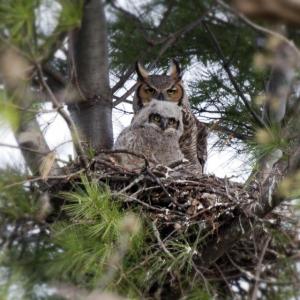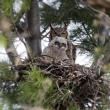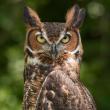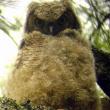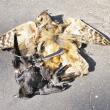Kristen Lindquist: Who-hoo-hoo's nesting in the winter?
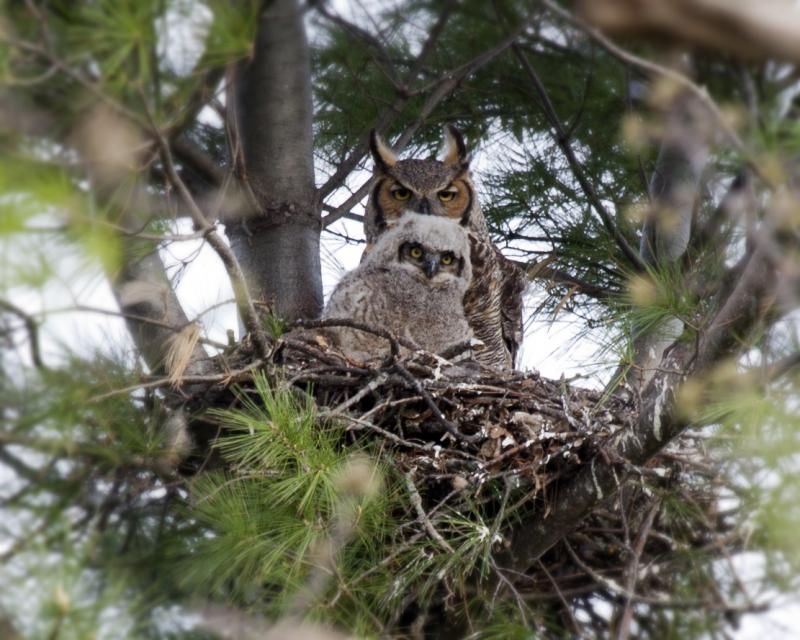 Great Horned Owl parent in the nest with its down-covered chick. (Photo courtesy John Kees)
Great Horned Owl parent in the nest with its down-covered chick. (Photo courtesy John Kees)
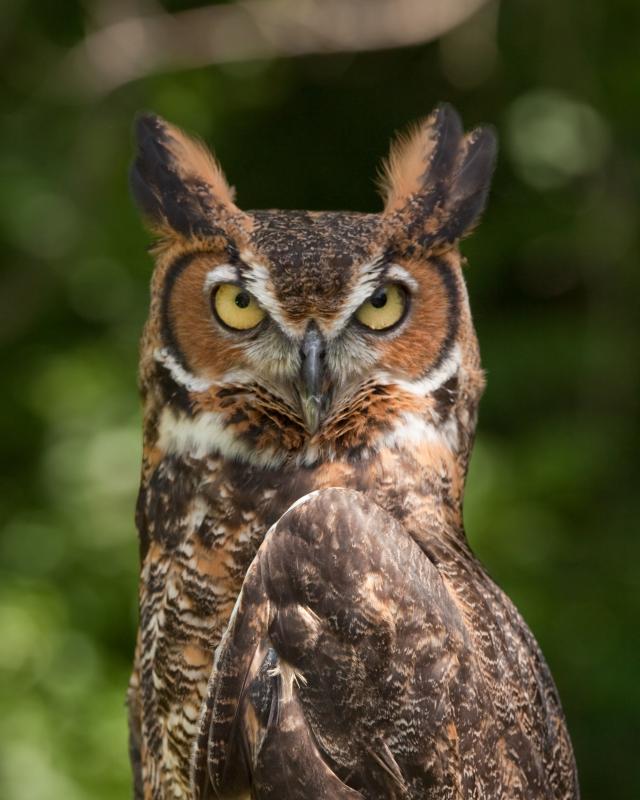 The "horns" of a Great Horned Owl are actually ear tufts. (Photo courtesy Greg Hume)
The "horns" of a Great Horned Owl are actually ear tufts. (Photo courtesy Greg Hume)
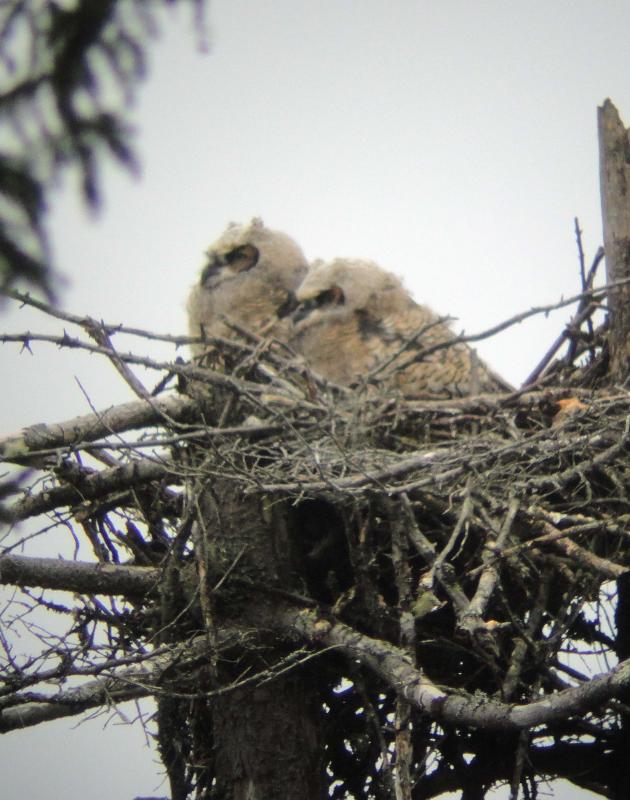 Great Horned Owl chicks in a nest on Vinalhaven. (Photo courtesy Kirk Gentalen)
Great Horned Owl chicks in a nest on Vinalhaven. (Photo courtesy Kirk Gentalen)
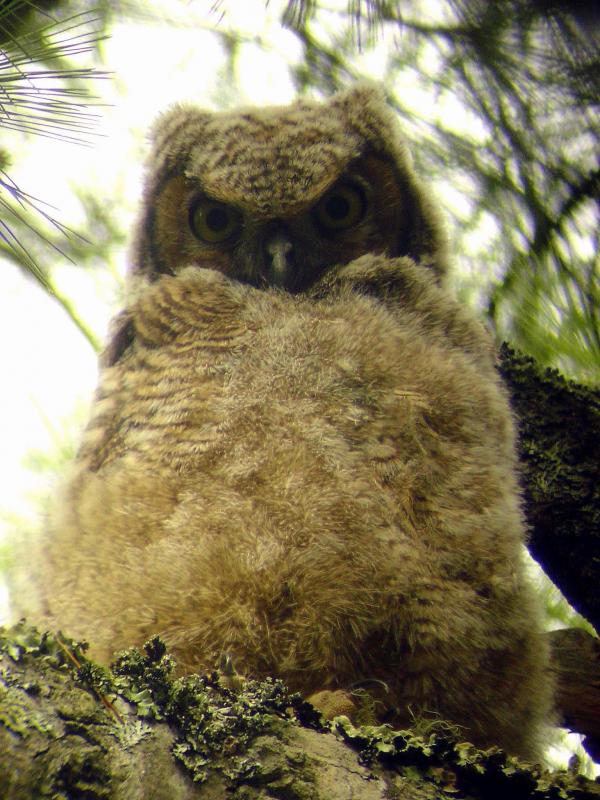 This curious fuzz-ball was spotted near a nest on Vinalhaven. (Photo courtesy Kirk Gentalen)
This curious fuzz-ball was spotted near a nest on Vinalhaven. (Photo courtesy Kirk Gentalen)
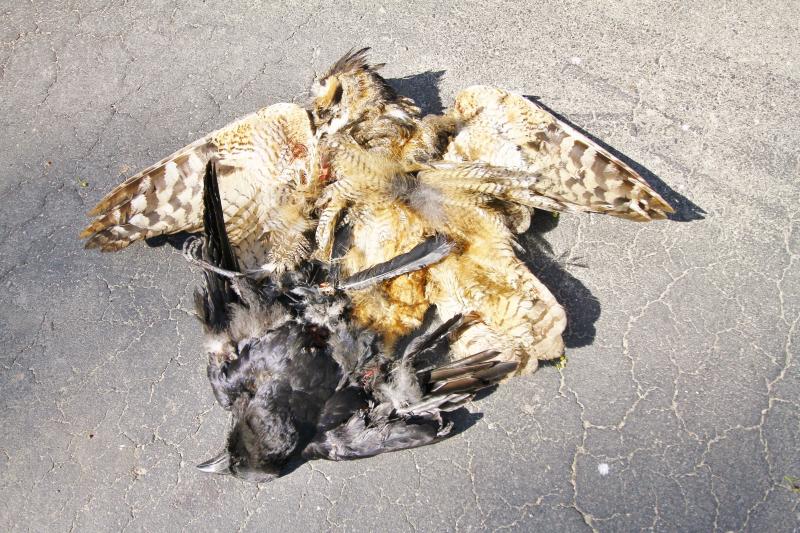 This Great Horned Owl was unfortunately struck by a car as it was flying off with its prey, an American Crow. (Photo courtesy Don Reimer)
This Great Horned Owl was unfortunately struck by a car as it was flying off with its prey, an American Crow. (Photo courtesy Don Reimer)
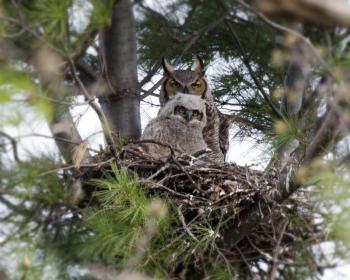 Great Horned Owl parent in the nest with its down-covered chick. (Photo courtesy John Kees)
Great Horned Owl parent in the nest with its down-covered chick. (Photo courtesy John Kees)
 The "horns" of a Great Horned Owl are actually ear tufts. (Photo courtesy Greg Hume)
The "horns" of a Great Horned Owl are actually ear tufts. (Photo courtesy Greg Hume)
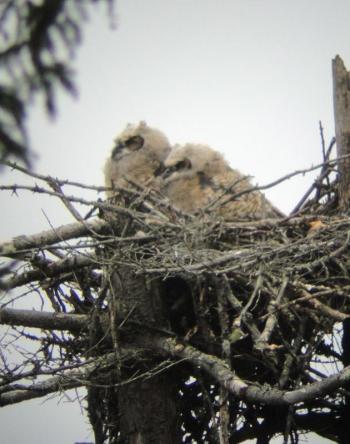 Great Horned Owl chicks in a nest on Vinalhaven. (Photo courtesy Kirk Gentalen)
Great Horned Owl chicks in a nest on Vinalhaven. (Photo courtesy Kirk Gentalen)
 This curious fuzz-ball was spotted near a nest on Vinalhaven. (Photo courtesy Kirk Gentalen)
This curious fuzz-ball was spotted near a nest on Vinalhaven. (Photo courtesy Kirk Gentalen)
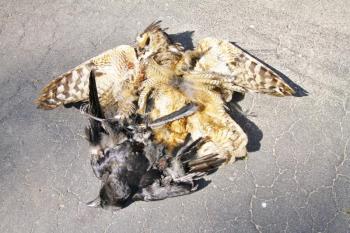 This Great Horned Owl was unfortunately struck by a car as it was flying off with its prey, an American Crow. (Photo courtesy Don Reimer)
This Great Horned Owl was unfortunately struck by a car as it was flying off with its prey, an American Crow. (Photo courtesy Don Reimer)
When we think of springtime, we think of birds returning from southern climes to brighten our trees once more. Of waking to flourishes of birdsong each morning. Of birds pairing up and nesting.
But for a few birds, by the time spring rolls around, that's all old news. By the start of the new year, Great Horned Owl couples have been carrying on pair-bonding courtship conversations for a few months already and have moved on to mating. Never mind the snow and bitter cold. For these owls, which may pair up for life, winter is the season for reasserting their home territory and getting down to the business of love and making babies.
If you are hardy enough to brave the winter chill after dark, you might hear the resonant voice of this quintessential "hoot owl" calling to its mate in the nighttime forest. The Great Horned Owl has a distinctive call of several hooted notes: "WHOO-hoo-hoo-hoo-o."
By comparison, the Barred Owl, the other large owl that commonly nests in Maine, says, "Who-cooks-for-you? Who-cooks-for-you-all."
I have sometimes mistaken these deep, low hoots of a Great Horned Owl for a dog barking off in the distance (and vice versa). The haunting sounds carry far and touch something within the reptile part of our brain. We listen to these calls with wonder, but they must inspire a feeling of dread in most of the smaller creatures that share the Great Horned Owl's territory.
In addition to being able to make itself at home in a wide range of habitats across most of the continent, this powerful night hunter is also cosmopolitan about its diet. It will eat pretty much anything it can kill, ranging in size from a snake to a Great Blue Heron, from a meadow vole to a Canada Goose—although studies have shown that its primary go-to food is usually mammals. Being unaffected by their noxious spray, the Great Horned Owl is a notorious hunter of skunks, for example. But in the forests of the Northeast, snowshoe hares and large rodents seem to be the preferred prey.
You can learn a lot about a Great Horned Owl's diet through examination of its pellets, those compacted lumps of indigestible matter that an owl coughs up after each meal. One of the best ways to discover an owl roost is to search around the base of big trees for pellets, which can be easily dissected to pick out the bones, feathers, and other bits. And if you find an active nest, animal parts, fur, and bones may be found hanging over its sides or on the ground below, more clues to what the birds are eating. Great Horned Owls are not fussy dieters or housekeepers.
Another way to find a roosting owl is to listen for crows. A flock of crows will mob an owl, diving at the bird and making a racket with their urgent, incessant cawing. Eyes closed, the owl usually looks unperturbed as it waits out these attacks, but it can sometimes be persuaded to move along. This harassment makes sense: a Great Horned Owl will predate a crow roost repeatedly—one of the reasons scientists believe that crows choose to roost in great numbers and near lighted areas like urban parking lots.
Regardless of weather and snow conditions, the Great Horned Owl pair is nesting by late January to early February here in Maine. They don't build their own nest, but instead will choose an abandoned nest of appropriate size—perhaps that of a squirrel, crow, Osprey, or even a Bald Eagle (although eagles are also among our earliest nesters). One of the reasons they're thought to nest so early is for this opportunity to pick a good nest without competition. Once a female owl has hunkered down on her eggs, it takes a lot to make her move. (Because if she does move, and the male isn't there to spell her, the winter air means doom for any eggs she was incubating.)
Another reason for their crazy early start is that Great Horned Owl chicks take a long time to mature. This is often the case with long-lived birds, especially those that are predators and need to learn the skills necessary to hunt successfully for themselves. The eggs hatch in about a month, so before spring has even officially arrived, most owl chicks will have emerged into the (probably cold and snowy) world. Their parents' bodies and lots of down feathers then keep them warm.
A little more than a month after hatching, just as the weather starts to warm up, the chicks become "branchers," flapping around outside of the nest and hanging out on nearby branches. The parent birds keep a close eye on these big gawky owlets, which often end up on the ground, and continue to feed and call to them regularly. The young birds' white, fuzzy feathers can make them seem larger than their parents, especially when they puff up in alarm.
About nine weeks after hatching, the kids are ready to fly. The mother owl will often encourage flight attempts by luring them off their perches with food. The whole family will remain together well into fall. The parents will continue to watch over and feed the chicks, which slowly learn the complicated tactics of night-hunting using their silent wings and heightened sense of hearing.
After their offspring finally disperse, the adult pair gets a few months' respite. By the time snow starts to fall, love is in the air once more and their courtship begins anew. Think of them out there now, the slightly larger female owl settled on the nest, her ear tufts (the "horns") making her look cat-like and alert. Perhaps a little snow has settled on her feathers. But underneath her rounded body, under those big brown wings and all that belly down, two eggs nestle, warm as the promise of spring.
Kristen Lindquist is an amateur naturalist and published poet who lives in her hometown of Camden.

Event Date
Address
United States

